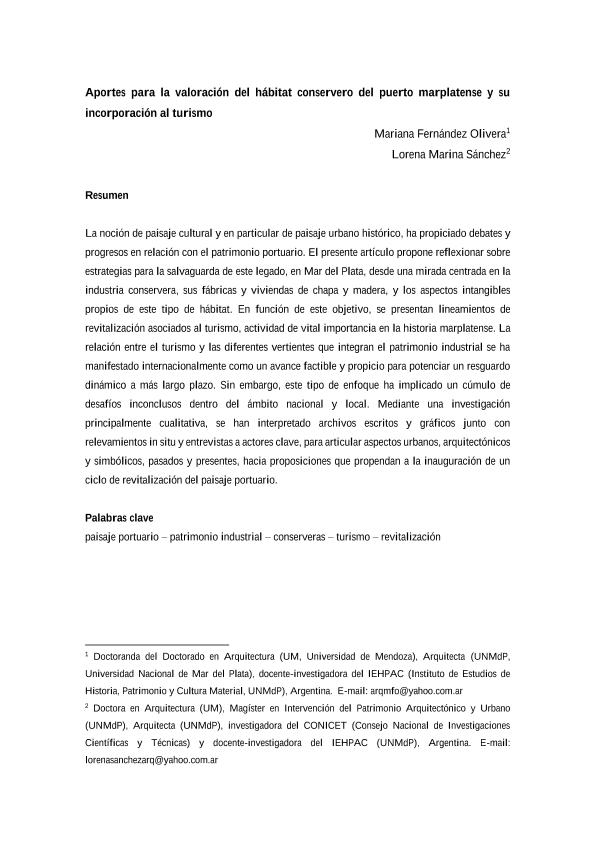Artículo
La noción de paisaje cultural y en particular de paisaje urbano histórico, ha propiciado debates y progresos en relación con el patrimonio portuario. El presente artículo propone reflexionar sobre estrategias para la salvaguarda de este legado, en Mar del Plata, desde una mirada centrada en la industria conservera, sus fábricas y viviendas de chapa y madera, y los aspectos intangibles propios de este tipo de hábitat. En función de este objetivo, se presentan lineamientos de revitalización asociados al turismo, actividad de vital importancia en la historia marplatense. La relación entre el turismo y las diferentes vertientes que integran el patrimonio industrial se ha manifestado internacionalmente como un avance factible y propicio para potenciar un resguardo dinámico a más largo plazo. Sin embargo, este tipo de enfoque ha implicado un cúmulo de desafíos inconclusos dentro del ámbito nacional y local. Mediante una investigación principalmente cualitativa, se han interpretado archivos escritos y gráficos junto con relevamientos in situ y entrevistas a actores clave, para articular aspectos urbanos, arquitectónicos y simbólicos, pasados y presentes, hacia proposiciones que propendan a la inauguración de un ciclo de revitalización del paisaje portuario. The notion of cultural landscape and, in particular, of historical urban landscape, has brought about discussions and developments, but there is still a long way to go in relation to port patrimony. This article proposes to reflect on strategies for the safeguarding of the port landscape of Mar del Plata from a perspective focused on the fish canning industry, its factories and houses of veneer and wood, as well as on the intangible aspects of this type of habitat. With this objective in mind, revitalization guidelines associated with tourism are presented. Tourism is an activity of vital importance in the history of Mar del Plata. The relationship between tourism and the different aspects that make up the industrial heritage, have been internationally recognized as a feasible and favourable development to promote a holistic protection in the longer term. However, this type of approach has implied an amount of unfinished challenges within the national and local level. Written and graphic archives, together with in situ surveys and interviews with key actors, have been interpreted mainly through qualitative research in order to articulate urban, architectural and symbolic aspects from past and present, towards proposals that put forward the inauguration of a cycle of revitalization of the port landscape.
Aportes para la valoración del hábitat conservero del puerto marplatense y su incorporación al turismo
Título:
Contributions to the appreciation of the fish canning industry habitat of Mar del Plata’s port and its incorporation into tourism
Fecha de publicación:
01/2021
Editorial:
Grupo de Estudios Sociales Marítimos
Revista:
Revista de Estudios Marítimos y Sociales
e-ISSN:
2545-6237
Idioma:
Español
Tipo de recurso:
Artículo publicado
Clasificación temática:
Resumen
Palabras clave:
PAISAJE PORTUARIO
,
PATRIMONIO INDUSTRIAL
,
CONSERVERAS
,
TURISMO
,
REVITALIZACIÓN
Archivos asociados
Licencia
Identificadores
Colecciones
Articulos(CCT - MAR DEL PLATA)
Articulos de CTRO.CIENTIFICO TECNOL.CONICET - MAR DEL PLATA
Articulos de CTRO.CIENTIFICO TECNOL.CONICET - MAR DEL PLATA
Citación
Fernández Olivera, Mariana; Sanchez, Lorena Marina; Aportes para la valoración del hábitat conservero del puerto marplatense y su incorporación al turismo; Grupo de Estudios Sociales Marítimos; Revista de Estudios Marítimos y Sociales; 18; 1-2021; 3-25
Compartir




